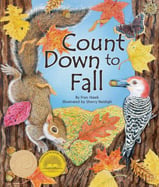Alignment to Standards for CA

| Grade | Number | Standard |
|---|---|---|
| 1 | 1 S ES--3.b. | weather changes from day to day but that trends in temperature or of rain (or snow) tend to be predictable during a season. |
| 1 | 1 S LS--2 | Plants and animals meet their needs in different ways. |
| 1 | 1 S LS--2.a. | Different plants and animals inhabit different kinds of environments and have external features that help them thrive in different kinds of places. |
| 1 | 1 S LS--2.c. | animals eat plants or other animals for food and may also use plants or even other animals for shelter and nesting. |
| 1 | 1 S LS--2.e. | roots are associated with the intake of water and soil nutrients and green leaves are associated with making food from sunlight. |
| 2 | 2 S ES--3 | Earth is made of materials that have distinct properties and provide resources for human activities. |
| 2 | 2 S ES--3.e.D144 | rocks, water, plants, and soil provide many resources, including food, fuel, and building materials, that humans use. |
| 2 | 2 S I&E--4.c. | Compare and sort common objects according to two or more physical attributes (e.g., color, shape, texture, size, weight). |
| 2 | 2 S LS--2.c. | many characteristics of an organism are inherited from the parents. Some characteristics are caused or influenced by the environment. |
| 2 | 2 S LS--2.d. | there is variation among individuals of one kind within a population. |
| 3 | 3 S LS--3 | Adaptations in physical structure or behavior may improve an organisms chance for survival. |
| 3 | 3 S LS--3.a. | plants and animals have structures that serve different functions in growth, survival, and reproduction. |
| 3 | 3 S LS--3.b. | examples of diverse life forms in different environments, such as oceans, deserts, tundra, forests, grasslands, and wetlands. |
| 3 | 3 S LS--3.c. | living things cause changes in the environment in which they live: some of these changes are detrimental to the organism or other organisms, and some are beneficial. |
| 4 | 4 S LS--3 | Living organisms depend on one another and on their environment for survival. |
| 4 | 4 S LS--3.a. | ecosystems can be characterized by their living and nonliving components. |
| 4 | 4 S LS--3.b. | in any particular environment, some kinds of plants and animals survive well, some survive less well, and some cannot survive at all. |
| 4 | 4 S LS--3.c. | many plants depend on animals for pollination and seed dispersal, and animals depend on plants for food and shelter. |
| 5 | 5 S LS--2.f. | plants use carbon dioxide and energy from sunlight to build molecules of sugar and release oxygen. |
| K | K S ES--3.b. | changes in weather occur from day to day and across seasons, affecting Earth and its inhabitants. |
| K | K S ES--3.c. | Students identify resources from Earth that are used in everyday life and understand that many resources can be conserved. |
| K | K S I&E--4.a. | Observe common objects by using the five senses. |
| K | K S I&E--4.b. | Describe the properties of common objects. |
| K | K S I&E--4.d. | Compare and sort common objects by one physical attribute (e.g., color, shape, texture, size, weight). |
| K | K S LS--2 | Different types of plants and animals inhabit the earth. |
| K | K S LS--2.a. | similarities and differences in the appearance and behavior of plants and animals (e.g., seed-bearing plants, birds, fish, insects). |
| K | K S LS--2.c. | identify major structures of common plants and animals (e.g., stems, leaves, roots, arms, wings, legs). |
| K | K S PS--1 | Properties of materials can be observed, measured, and predicted. |
| K | K S PS--1.a. | objects sorted by the materials they are made of and their physical properties (e.g., color, size, shape, weight, texture, flexibility, attraction to magnets, floating, sinking). |